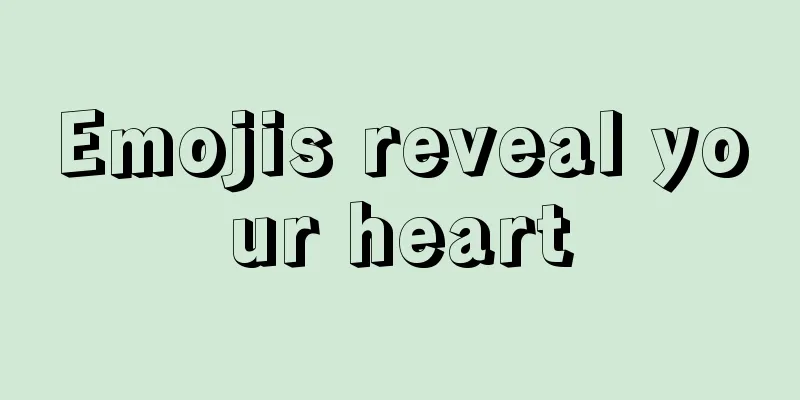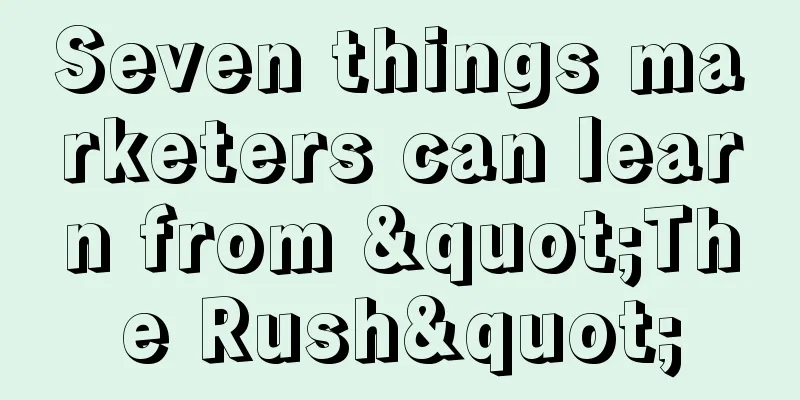Emojis reveal your heart

An important rule in the “Internet Handbook for Catching Adultery”: If a lover uses an unfamiliar “cute emoticon package”, then it must be exogenous - saved when chatting with other ambiguous objects. Compared to lipstick marks and perfume smells in the pre-Internet era, emoticons as evidence of deviance seem both sufficient and not so sufficient. But just like the belief that certain avatars can attract wealth and romance (A Brief History of Human Avatars), the belief that emoticons can reflect personality traits and living conditions has become a consensus among many people surfing the Internet. In the process of spreading emoticons, images and texts carry different stories and activate different cognitive archetypes. They meet in a specific subculture context and eventually proliferate and replicate. For example, Fu Yuanhui's classic emoticon "I have used all my strength" is widely used in various contexts to express the degree of effort one puts into doing something. This emoticon was directly transferred from the original context (Fu Yuanhui's post-match interview) to the new context, and its original meaning and humorous style have not changed. However, it is more common that emoticons are "reconstructed" during the production and use process. Yi Yang Qianxi's expression of firing a cannon comes from the behind-the-scenes footage of the movie "Miracle Stupid Kid", and its meaning has changed from being tired to ruthlessly firing a cannon to maintain justice; the domestic monkey gif from Southeast Asia, combined with the Guangxi cousin's "Malo's life is also life", gave birth to the "Malo culture" with a variety of strange meanings; not to mention Loopy (Ruby), a supporting role in Korean animation for many years, who was promoted by netizens to become the top emoticon package and the most frequently appearing "pink mouse" in the chat box. Obviously so cute, but the text is so crazy; and the "Speechless Bodhisattva" who suddenly swept the screen this summer, his real identity is actually an Arhat! The strong appropriation and core transformation of emoticons really makes any entertainment company feel daunted and inferior. No matter how unknown you were before, as long as you are made into the king of emoticons, it means that traffic and money are beckoning. 1. The earliest "crazy" TuzkiThe first emoticon was created as early as 1982, but the real popularity of emoticons in China is thanks to a local rabbit. Tuzki, without complicated colors, is only drawn with black lines. With thin and long ears and arms as soft as noodles, he always squints his eyes and has a mean expression. In 2004, Wang Maomao, a student at the Animation Department of Communication University of China, started a blog and used a rabbit image to write a diary. At first, the rabbit was just used to record interesting things in Wang Maomao's life, but later she gradually enriched the rabbit's personality, making it playful and a little nonsensical. While eating spicy hot pot, a senior student reminded Wang Maomao that she could draw rabbits as a series. Wang Maomao was awakened by this and began to consciously create the image of Tuzki. In September 2007, her blog hits exceeded 7 million times, which is a data that cannot be underestimated in the blog era. The viral spread of Tuzki was due to the widespread use of QQ and MSN at the time, when users generally lacked a medium to express emotions other than text. Wang Maomao's classmates first spread it on the forum, and then it was uploaded to a blog for netizens to download. QQ, MSN and Baidu Tieba were all filled with Tuzki emoticons. Compared with the "madness" of the post-95s and post-00s, the "madness" of the post-80s and post-90s represented by Tuzki is more like a carbonated drink that regulates emotions, a shallow rebellion and cynicism. Although born in the college student group, Tuzki does not have elite attributes, but is a typical product of the grassroots Internet culture at that time. When it is happy, it can dance like Haidilao noodles, when it is depressed, it will directly bang its head against the wall, and it will also pretend to be a good child reading a book but yawning all the time... Tuzki reflects the optimistic and occasionally depressed life attitude and life state of that generation of young people. Compared with the weird Loopy, Tuzki is really full of positive energy. Although he is also crazy, he is basically crazy for a short time, and then he goes back to work and study. In the picture book "I'm Tuzki, You", Wang Maomao even turned Tuzki into a Cai Gen Tan-style illustrated chicken soup. The smiling Tuzki actually looked up at the starry sky at a 45-degree angle, saying irrelevant truths. "It is meaningless to deliberately change yourself for others, because then you are no longer yourself." In the 2016 revised edition, Wang Maomao tried to upgrade Tuzki to a "philosophy of life". As a result, old fans complained, "Just be funny and cute, there is no need to apply philosophy everywhere." From a creative perspective, the deliberate emphasis on value and chicken soup has eliminated the most shining vitality of Tuzki. Even though the students who used Tuzki back then have long since become office workers, most of them still miss the contrast of the sudden unseriousness in the serious atmosphere, rather than really wanting to learn something. In the virtual space, emotional relief brought by emoticons is easily accepted, while intervention emotional help in real life is easily resisted. Yohi Monkey, Ali, and Onion Head, who were contemporaries of Tuzki, have basically disappeared. But this group of veteran emoticon idols truly demonstrated the powerful power of virtual symbols. Like pixel-based avatars, they established the first generation of emotional connection between the Internet and users. 2. Monkey, Pig, Yi Yang QianxiBack in the Internet mythical period of "Emperor Bar Expedition", emoticons were already an indispensable strategic material. At that time, emoticons were mostly in the form of pictures and texts. Yao Ming, Huang Zitao, Jin Guanzhang, exaggerated stills of stars, and propaganda posters with a sense of the times combined with Internet buzzwords were the most common forms. The relationship between language and image is neither a monologue description of text elements nor a dominant narrative of image elements, but an expression of the theme of satire, subversion and marginal resistance in the dialogical context relationship jointly constructed by text and image. The disadvantage of this kind of text-image collaboration is that the text cannot be separated from the image, and the image cannot explain the text. If one is missing, the meaning will be ambiguous. The fundamental reason is that the user has not created an emoticon idol with a stable connotation, which results in each emoticon package needing to be retouched with text. Fortunately, this major issue in the emoji world has been systematically resolved this year. Whether it is Malo, Pigsy, Loopy, Bodhisattva or Yi Yang Qianxi, they no longer rely on text descriptions, but have clear core directions themselves. The Malo emoticon package can be regarded as a variant of "Mouse Literature", "Langlangshan Literature" and "Kong Yiji Literature". It generally expresses the general mentality of marginalized people and vulnerable groups (or groups that are not actually vulnerable but feel sorry for themselves) in society. "You like the Monkey King, but I am a Malo", "When a fish cries, the water knows, but when Malo cries, who knows", "Malo can't understand the school notice and is scolded every day". At the same time, the Malo emoji package has also been transformed by sexual minorities into a meme with a small circle of interest. Jason, a familiar face in the Malo emoji package, often spins around with a schoolbag on his back, looking gay. Under his angry videos, there are often contacts who make fun of "U Bear stood him up" and "The monkey's only destiny is to cook for the bear." The Pig Man emoji package has become popular with the expressions "jaw dropping" and "being kidnapped everywhere". Pig Man also seems to embody the difference in aesthetics between men and women in emoji packages . A netizen often posts Pig Man's surprised expression, but his girlfriend stopped him from posting this dead pig. He angrily replied, "It's not a dead pig, it's my idol." Vulgar or ugly and cute, that is the question. "Beautiful lady, my name is Bond, GG Bond." In this self-introduction of Pig Man, Bond is James Bond, and GG is the transliteration of the Cantonese word Ju Ju (pig). The difference between the two is huge. Another popular event was when a college student photoshopped a picture of Peppa Pig and Lazy Sheep tied to a tree and asked which one was tastier. Netizens followed suit and tied Peppa Pig to various things. The Blue V police used the kidnapping of Peppa Pig to promote anti-fraud knowledge, the Wuhan Tourism Bureau tied Peppa Pig to the Jianghan Customs to attract tourists, and the fire department’s official media tied Peppa Pig to a boat to promote drowning prevention knowledge. Just like kidnapping Pig Man, a photo of Yi Yang Qianxi with his eyes closed and legs hugged on the set has entered a new world in the netizens' live broadcast. It's not that the Italian cannon is unaffordable, but it's more cost-effective for Qianxi to carry the cannon. He who holds a gun is a special forces soldier, he who sits on a tank is a tank soldier, he who is on a plane is an air force soldier, and he who is on a warship is a navy soldier. No branch of the military can escape Qianxi's palm. It was obviously a tired snapshot, but it was transformed into a weapon for netizens to fight against each other. Justice is absent, but Qianxi is present. When you are furious in the comment section, Qianxi will carry a Gatling gun to help you. 3. What new tricks are there in the emoji market?When you spend money on emoticons, you are not buying emoticons, but a lively commercial idol. When Tuzki became an instant hit, Wang Maomao was rumored to be the biggest winner. At first, Yikai Design Company launched a series of Tuzki products, including notepads, postcards and T-shirts, which were all sold out. In July 2007, Wang Maomao terminated her cooperation with Yikai and started a new business to develop Tuzki's brand. During the 2008 Beijing Olympics, she updated "Tuzki Olympic Trip" in Beijing Daily, providing a new story line for Tuzki. Later, Wang Maomao sold the film and television rights of Tuzki to Warner, and was called "marrying far away" by the media. However, in 2016, Tencent Pictures announced the adaptation of "Tuzki" into a live-action movie, and in 2019, Warner and Ciwen Media wanted to create a live-action animated series of "Tuzki", but neither project had a follow-up. The early commercialization of emojis was close to the operational thinking of animation IP, which was nothing more than derivatives and animation. 2023 can be called the "year of joint ventures" for new consumption, and emojis are one of the winners of joint ventures. To know what emojis are the most popular nowadays, just look at the milk tea on the street. On Children's Day, the "Watermelon Coconut" co-branded product of Lelecha and Loopy sold 65,000 cups; the peripheral plush mirror pendants were limited to 4,500 pieces nationwide and sold out within a minute; in July, MINISO launched Loopy dolls, and the online mini program was crowded. In South Korea, where its IP was born, Loopy's co-branding covers everything from luxury goods to catering, and its cooperation with Burger King Korea, Jeju Airlines, Bulgari watches, and ketchup has set off a "pink storm." It feels like the last foreign cute top star was Lingna Belle, but I didn't expect the throne to change hands so quickly. Loopy is from the 2001 Korean cartoon "Pororo the Little Penguin", but she is not the protagonist of the animation, but just a good friend of the protagonist Pororo. More than 20 years have passed, and the protagonist has been forgotten, but Loopy has become popular again with the sense of substitution. Everyone can be Loopy, the background board of the animation, the NPC of the world, and the "me" that is ignored in daily life. Loopy is a bit like the piglet in Langlang Mountain, a natural worker, with a cute, calm but crazy mental state. He has the calmness of "I'll just watch you pretending to be cool" and the attitude of "what else can you do to me". It is a kind of impoliteness disguised as politeness, a pseudo-offense after an offense is modified. "I'll turn this rotten world upside down in my dreams", "Believe it or not, I'll beat you up", "Although I didn't do anything today, I still worked hard on myself"... Looking at the speeches of the starchy little beaver, I feel that the most original one is the "Xi Ba", which is full of Yanzhen flavor and crazy feeling. Of course, the emoji business is not without risks. The "Buddha Latte" jointly launched by Heytea and Jingdezhen Museum is riding on the popularity of the Internet celebrity "Silent Bodhisattva", but the religious elements in the packaging make people feel puzzled: should we throw it in the trash after drinking it or take it home to worship it? Fortunately, the relevant departments are also afraid of violating taboos. On December 1, Heytea was interviewed for suspected violations of the Regulations on Religious Affairs. Two days later, Heytea removed three related products from the shelves. Back to the "Silent Bodhisattva" itself, it is also a strong transformation of the emoticon package. On the one hand, it is one of the "Underglaze Colored Eighteen Arhats" created by Zeng Longsheng, and it is an Arhat, not a Bodhisattva; on the other hand, the expression of the Arhat is not speechless, but "contemplative". By decontextualizing, the image elements are in a state of delocalization, which gives the meaning of emoticons an elastic space. Going crazy in this elastic space is a reflection of the compression of real space. Going crazy with emoticons seems to make us appear not that crazy, but polite and cute. Author: Xie Minghong; Editor: Li Chunhui Source: WeChat public account "Entertainment Hard Candy (ID: yuleyingtang)" |
<<: The Godly Copywriter in the Retarded Bar
Recommend
How do I delete a product on Wish? How do I restore a product that was deleted by mistake?
With the rapid development of e-commerce, Wish, as...
As we enter the stage of deep cultivation of all channels, how can snack food brands achieve certain growth?
In the process of channel transformation, what cha...
I am a Chinese brand, how should I choose my English name?
This article focuses on the management of English ...
Growth Talk: North Star Indicator
The North Star Metric (NSM) plays an important rol...
A hit product in 1 day! DeepSeek+comfyUI+KeLing AI video creation process disassembled, hand-in-hand teaching you how to use AI to make short videos
In the era of short videos, how to quickly and eff...
Is the Amazon VC account operated by Amazon? Will the VC accounts be linked?
The full name of Amazon VC account is Vendor Centr...
Friends' conversation records: Detailed explanation of Guanxia's 4 "emotional marketing" methods
Introduction: This article starts with Guanxia’s f...
Can I appeal to regain my Amazon store association? What are the consequences?
After your store is linked on Amazon, you generall...
Not all live broadcasts of debt repayment are called "real debt repayment"
Live streaming to pay off debts has become a choic...
From Jingzhe to Spring Equinox, Banana is one step closer to life
This article reveals how Jiaoxia integrates lightw...
The “emotional value” of classic advertising
This article introduces three classic cases in the...
How can I combine the shipping costs when buying multiple items on eBay? Is the shipping cost the same for everyone on eBay?
When shopping on eBay, sometimes we may want to bu...
On Douyin, no one can escape the abstract live streaming of goods, which is much more abstract than the shaman dance.
From the rich lady character of Macau's Coco S...
What are the differences between cross-border e-commerce B2B and B2C? Which one is better?
Cross-border e-commerce actually has many operatin...
With tens of millions of private domain users accumulated in two years and a GMV exceeding 200 million, what is the advantage of Refeng’s private domain?
In July 2020, Hotwind officially built its brand p...









